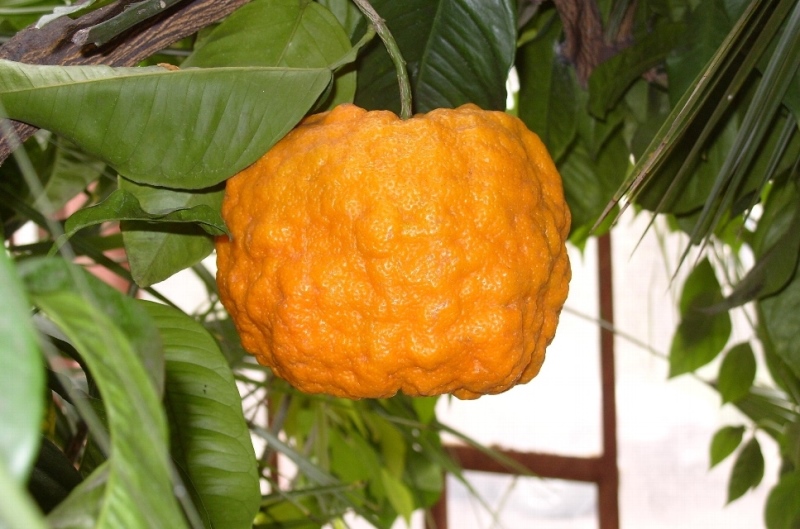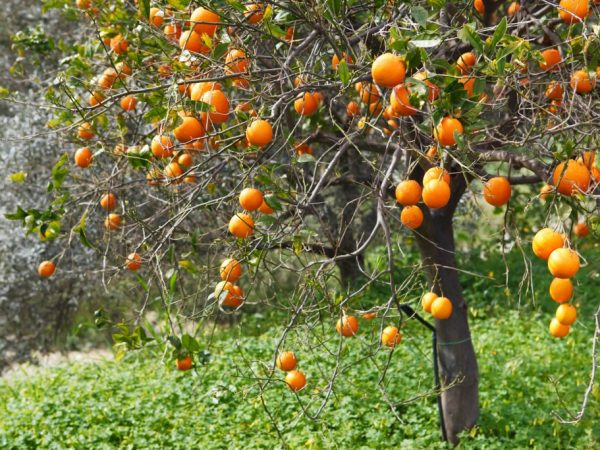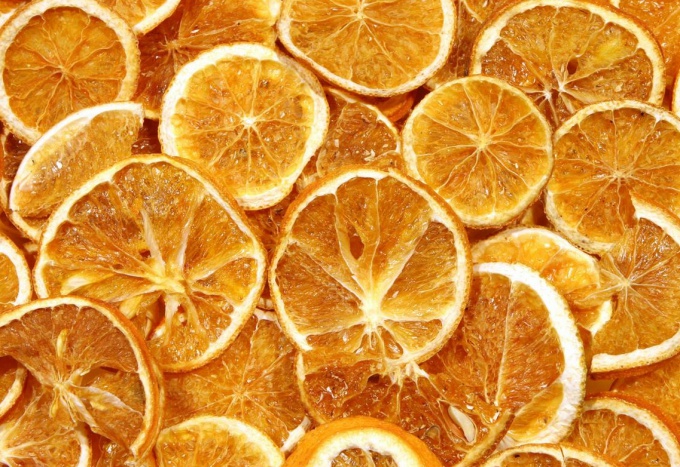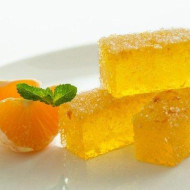What is useful and how to grow a bitter orange at home (orange)
Content
History and places of growth of the orange
Bitter orange is often called orange, quinotto, bigarady, wild or wild orange. However, not all names are related to this type of citrus. For example, it is wrong to call a wild orange a wild orange because the plant does not occur in the wild. Most variegated citrus fruits require careful maintenance and special growing conditions.
The history of the bitter orange is no less mysterious - there is no exact version of the origin of the citrus. The orange is considered to be a hybrid form of pomelo and mandarin. Southeast Asia is called the birthplace of culture. Today it is massively cultivated in Japan, Australia, South America, the Mediterranean countries and the Caucasus. Can be grown as an ornamental indoor plant.

Video "Acquaintance with the Fasciata orange"
This video provides a detailed description of the citrus crop.
Characteristics of the variety
According to the botanical portrait, the orange belongs to the evergreen thermophilic tree crops of the Rutaceae family.
Description of the tree
The growth of a tree grown in the open field ranges from 2 to 10 m. The height of the indoor orange does not exceed 1 m. The branches of the citrus culture are thin and elongated. On the trunk and shoots there are small pointed thorns, which are designed to protect against herbivores.
Oval-shaped sheet plates with a smooth glossy surface deserve special attention. The outer side of the leaf is painted in a juicy green shade, the back - in a faded green. During the flowering period, which occurs in the second half of spring, the plant is covered with numerous snow-white flowers. A distinctive feature of bigaradia is its captivating aroma during the flowering period.

Description of the fetus
Citrus fruits are characterized by a spherical and slightly flattened shape. The bright orange peel has a bumpy surface. The pulp of the bitter orange fruit consists of 10-12 slices, which are easily separated from the peel. The taste of the fruit is sour, bitterness is present.
Composition and medicinal properties
The orange is unique in its chemical composition. So, ripe fruits contain malic, citric, salicylic and gallic acids, glycosides and carbohydrates. Leaves, flowers, young shoots and pre-mature fruits are highly prized by essential oil producers. Petitgrain orange oil is characterized by a subtle, captivating aroma, in which notes of lemon are inherent. However, in its composition and useful properties, orange oil is more similar to orange oil.
Bitter orange extract has a wide range of effects on the human body:
- antiseptic;
- anti-inflammatory;
- antimicrobial;
- antirheumatic;
- antispasmodic;
- pain reliever;
- expectorant;
- wound healing;
- diaphoretic;
- choleretic;
- deodorant;
- antitoxic;
- tonic;
- stimulating, etc.
Orange is recommended for colds and acute viral infections, disorders of the digestive and cardiovascular systems, nervous disorders. Energy value of bitter orange (per 100 g) is 53 kcal. The amount of carbohydrates reaches 11.54 g, fats - 0.31 g, proteins - 0.81 g.
Growing at home
Bitter orange can be grown on a windowsill. So that the plant does not lose its decorative qualities, it is necessary to adhere to certain growing conditions.

Optimal conditions of detention
Growing in a flower pot, citrus loves warmth and sun. But the abundance of sunlight can lead to leaf burns. The best option is diffused lighting. For comfortable growth and development of the orange, the air temperature in the room should be in the range of + 20… + 25 ° C.
General rules of care
Why does the indoor orange not bear fruit? A similar question can often be heard from budding citrus growers. There is only one answer: improper care of an exotic culture. First, growing a bitter orange requires a loose and nutritious medium. Therefore, the plant is periodically fed with liquid mineral or organic fertilizers. Secondly, in the warm season, the tree requires abundant watering, in the cold - moderate. To moisten the soil, settled water at room temperature is suitable. After each watering, shallow loosening of the upper soil layer is carried out.
Bitter orange application
Due to its rich chemical composition, bitter orange is actively used not only in cooking and dietetics, but also in cosmetology, aromatherapy, folk and oriental medicine.
In cosmetology
In the cosmetic industry, bitter orange oil is used in shampoos, rinses and hair conditioners, body lotions and creams, anti-cellulite scrubs and deodorants.
Cosmetic masks and creams improve microcirculation and metabolism of the treated areas. Shampoos based on petitgrain orange oil prevent hair loss and dandruff. The extract helps fight adolescent acne and acne, moisturizes the skin and improves its elasticity.

In aromatherapy
The extract is no less popular in aromatherapy and perfumery. Citrus oil is found in fragrances and bath additives. The product is actively used in spa salons for relaxing treatments. The previously popular orange water is back on the shelves of perfume shops.
In folk and oriental medicine
As for traditional and oriental medicine, bitter orange can be called a panacea for many diseases. The product and the products made from it are recommended for eliminating blood stasis, relieving pain, headache and vascular spasms, reducing tumor-like formations of unknown origin, stimulating appetite, and normalizing the work of the heart muscle. Orange extract has a calming effect, relieves stress and improves mood. Bigaradia fruits are capable of generating vitamin D in the human body.
In dietetics
Synephrine - one of the components of bitter orange peel - is a part of biological additives that are used in dietetics and sports nutrition. The alkaloid synephrine activates metabolic processes in the human body, while the process of fat formation is actively suppressed.
Please note that the use of such a strong alkaloid requires the supervision of a dietitian and / or trainer. Self-designation can lead to a deterioration in well-being and the development of dangerous pathologies.
In cooking
The orange became widespread in cooking and confectionery. The product is used for the preparation of various drinks, sauces and marinades, salad dressings, and various desserts. Citrus zest is added to ice cream, marmalade, candy, cupcakes, cakes and curd desserts.
The fruits that have not reached technical maturity are used in the alcoholic beverage industry for the production of alcoholic beverages.
- Candied fruit
- Jam
- Marmalade
Collection, preparation and storage of medicinal raw materials
Bigaradia oil from the peel is obtained by pressing without heating from flowers and unripe fruits - by means of extraction with fatty oils. At home, you can only prepare the peel and pulp of a ripe fruit. So that the fruit does not lose its useful and medicinal properties, the peel and pulp cut into circles or strips are dried in electric dryers.
You can store the dried product for 2-3 months. In this case, the air temperature in the room should be low, and the humidity - high.

Contraindications
Orange is contraindicated for allergies and individual intolerance. It is better to refuse to eat bitter-sour citrus during pregnancy and breastfeeding. Bitter orange extract is a poison for hyperacid gastritis, since it stimulates the active secretion of gastric juice.
Despite its many beneficial and medicinal properties, excessive eating or topical application of bitter orange can backfire. In order to avoid unpleasant and sometimes even dangerous situations, we do not recommend self-medication.



